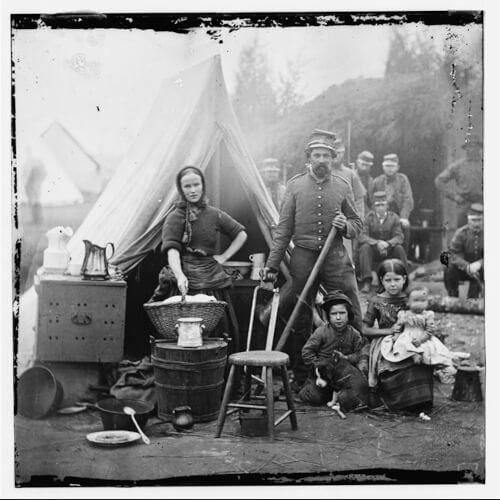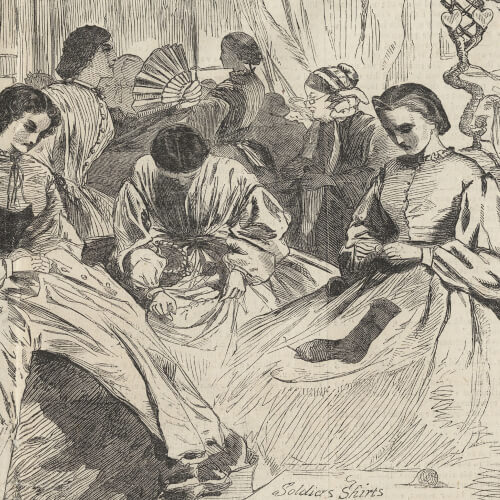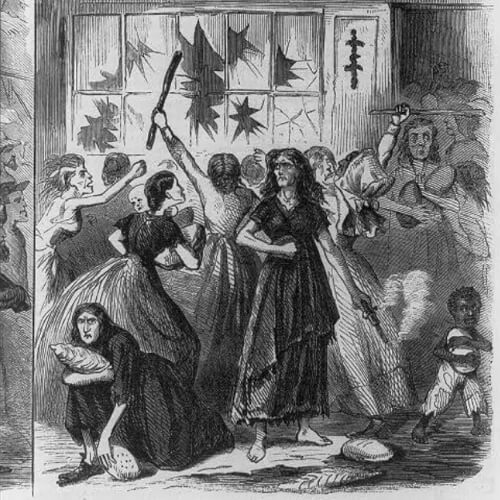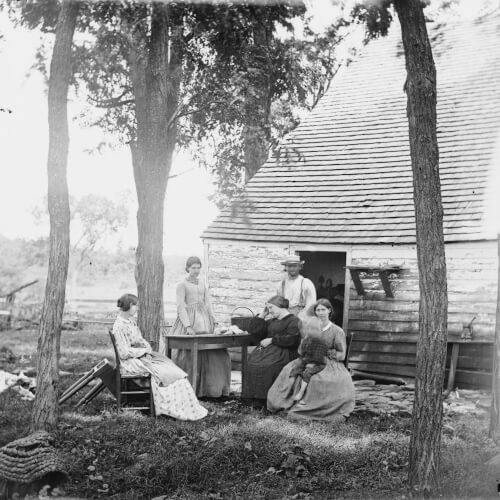The Homefront During the Civil War
Exploring the life at home and away from the ravages of the Civil WarThe Home Front
The lives of the troops who fought in the Civil War were altered. However, the war also affected and permanently transformed civilians on both sides. In addition to providing for their families, women had to assume the responsibilities that their husbands had had before to the conflict. On the home front, people had to deal with issues including inflation, a lack of supplies, illnesses, and extended stretches without hearing from their loved ones. Many people resided in the areas where the soldiers battled or passed.
Women started to assume more and more responsibility because there were so many males at war. In the South, wealthy women would frequently run the farms while their husbands were at war, acting as plantation masters and overseeing large slave populations. Meanwhile, underprivileged women took on the physically taxing work of farming, frequently performing tasks that would have typically been performed by their husbands and sons. Women in the North assumed the majority of manufacturing jobs, which was essential to the war effort’s ability to successfully supply the Union troops.
The Northern Homefront
When the Civil War first broke out, the North significantly outnumbered the South in terms of manufacturing capacity, food supplies, and population. Shipments of food and equipment were transported over 22,000 miles by railroad from fields to towns. Twenty million people, including a sizable immigrant population, served as a significant source of soldiers and laborers for farms and factories. Manufacturing, textile milling, shipping, and enterprises including shops, financial institutions, and professions like law and medicine made up the industrial sectors in the northern cities. Despite having big cities, the majority of people in the Union worked on farms. Small vegetable farms in the northeast and big ranches in the west made up the different sizes of the farms. Before the war, workers toiled in the fields, raising apples, vegetables, potatoes, feed and hay for livestock, and grain. In addition to working in the fields, a hired laborer might also eat and sleep with the family.
Shifting Responsibilities
During the war, women’s positions underwent a significant shift. Women from the North were already well-represented in a number of businesses prior to the conflict, including textile, apparel, and shoe manufacturing. With the war, there was a significant increase in the number of women working in fields ranging from government civil service to agriculture. Women were employed at munitions plants, arsenals, and textile mills as a result of efforts to provide soldiers with weapons and clothing. When the farmers marched out to war, women took up their plows and started running the farms in addition to their regular home responsibilities. Approximately 20,000 women contributed to the Union military effort. About 3,000 middle-class white women worked as nurses, while working-class white women and free and enslaved African-American women worked as laundresses, cooks, and “matrons.”
The Southern Homefront
The South’s residents endured many of the same challenges as the North’s population. Women took on additional responsibilities when males left to fight in wars. Long weeks went by with no word from soldiers on the front lines, supplies were scarce and inflation was much worse than in the North. The women took over as many companies as they could when the males went to battle. Like the ladies of the North, they organized knitting and sewing clubs and took on nursing responsibilities. Supplies for southern women became much more scarce than in the North, and many of them struggled to provide for their children.
The majority of military operations were concentrated in the South, thus those on the homefront there were familiar with the hardships of war directly. In 1861, a naval blockade by the Union prevented a large portion of the South from accessing both necessities and luxuries. Both Union and Confederate deserters roamed in packs, robbing farmers of their harvests and cattle, while Union officials seized food supplies for the army. In response to material shortages, white women in the upper and lower classes turned to their homes to make basics like clothing. Women found themselves in the position of protector against soldiers looking to plunder homes of jewels, food, and other stuff because there were no men present in their homes.
Supply Shortages
The prospect of famine was the most important issue for many Confederate civilians. A drought in 1862 that lowered food supplies, a reduced labor force on farms and plantations as enslaved people fled to Union lines, and Federal forces taking control of additional Confederate territory were only a few of the factors that contributed to widespread food shortages in the South. What little food was allocated for civilians frequently went bad before it could be sent from warehouses because the Confederate army had priority in terms of transportation. Farmers replied by concealing their harvests and cattle in response to the government’s attempt to improve the situation by impressing food. Food costs increased dramatically as a result of hyperinflation, while the value of the Confederate dollar plummeted.
Food riots soon erupted in a number of towns, including Richmond, the Confederacy’s capital. Confederate President Jefferson Davis gave the order to fire on several hundred women if they did not return home during the “Richmond Bread Riots” in April 1863. Thankfully, no carnage occurred once the women returned home. The price of flour reached $275 a barrel in Lynchburg, Virginia, by the end of 1863. To avoid going without, civilians had to discover alternatives for things like coffee, sugar, and meat. Families were obliged to find other means of support as a result of the Civil War’s food shortages.
Ammunition
Richmond Bread Riots
Food riots soon erupted in a number of towns, including Richmond, the Confederacy’s capital. Confederate President Jefferson Davis gave the order to fire on several hundred women if they did not return home during the “Richmond Bread Riots” in April 1863. Thankfully, no carnage occurred once the women returned home. In 1861, a pound of bacon cost 12.5 cents; in 1865, it cost $11. The price of flour reached $275 a barrel in Lynchburg, Virginia, by the end of 1863. To avoid going without, civilians had to discover alternatives for things like coffee, sugar, and meat. Families were obliged to find other means of support as a result of the Civil War’s food shortages.
Lives of the enslaved
Slave women’s lives underwent significant alteration as a result of the war. Many wives of slaves who the Confederate army persuaded to work as laborers on military-related projects were separated from their husbands for the length of the war. As they attempted to take over their husbands’ responsibilities while they were away, slave women’s labor in the fields and at home rose. Slave women’s lives were particularly impacted by shortages on the home front. Slave owners cut back on the clothing, food, and medical care they provided for their charges. Bondwomen struggled to fight off disease and starvation in their families as a result. In addition, slave women were primarily in charge of home production, spending long hours weaving, spinning, and producing soap in addition to their strenuous farm labour.
Not All Men Fought
Men who chose to stay at home frequently felt that their duty to their families came before serving in the military, yet these men were not always against the war effort. Popular ideas about manhood and honor during the American Civil War demanded that men enlist in the military. But not all men could or would participate in the wartime military. Some males enlisted in the military for brief stints but opted against long-term service. Both the Union and the Confederacy employed a large number of civilian employees to carry out crucial duties like managing the government, maintaining domestic security, and running crucial wartime enterprises. Other civilian men disagreed with the conflict and chose not to participate, or they merely felt that protecting their homes and supporting their families came first.
Businessmen who stayed at home during the war ran the risk of being derided by their neighbors as profiteers, but some professions were deemed too crucial for men to abandon. Numerous businesspeople and traders contributed financially and via their leadership in the community to the war effort. Prominent merchants contributed to relief efforts for the families of troops and provided monies for bounties to entice men to enroll.
Changing Gender Roles
In the manufacturing industry, women made up 25% of the workforce as of the 1860 census. But the pay was frequently extremely low, the hours were grueling, and the working environment was occasionally hazardous. Large numbers of women also entered the nursing and teaching fields, gradually coming to be associated with them. The Civil War enhanced women’s social advancement. Women were now able to leave the home because of their unselfish commitment to a cause.
The women who had maintained the home front for four long years found themselves displaced with the end of the war and the return of the troops to resume their civilian lives. However, they were reluctant to return to their pre-war position. After experiencing independence and responsibility, many of them continued their volunteer work in the community, entered the workforce in a variety of occupations, and increased their attendance at colleges and universities in an effort to reclaim the freedom and authority they had during the Civil War.
Learn More
Videos
Vocabulary
Bounty – A sum of money paid to entice enlistment in the military.
Bummers – Foraging or marauding soldiers in the Civil War.
Carpetbagger – A derogatory Southern term used to identify a corrupt Northerner who came South after the war in order to use the political process for self-enrichment.
Conscription – The Civil War name for what is now known as the draft.
Forage – living from the land, obtaining food from the countryside, sometimes forcibly taking it
Furlough – A leave granted to a soldier by his superior.
Homefront – the civilian population and activities of a nation whose armed forces are engaged in war.
Housewife – A small sewing kit, usually handmade, carried by soldiers and sailors during the Civil War.
Impressment – The seizure of private property.




